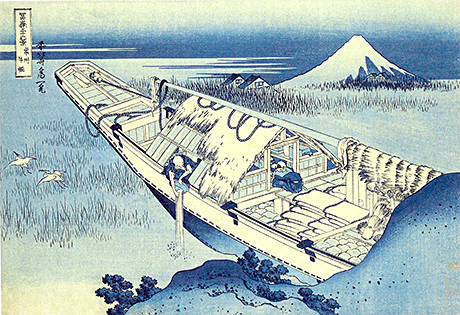
Japanese Wooden Boats in Woodblock Prints
A Research Project Journal
6 January 2007
By Michelle Damian

In a conversation several years ago, I told someone that I was interested in studying Japanese maritime archaeology. Their immediate question was “Are there shipwrecks out there?” Although Japan is an island country, and indeed ships have historically played an important role, it’s surprising to me that so few Westerners have taken interest in Japan’s maritime culture. Even in Japan itself, maritime archaeology is a very new field, and little has been written in English about projects there.
I entered the Program in Maritime Studies at East Carolina University (ECU) intending to learn the skills needed to study Japanese maritime archaeology, and to promote that knowledge to the Western world as well. For my master’s thesis project, I’ve chosen to examine late Edo period (1603 – 1867) inland watercraft to learn more about Japanese ship construction and the role these vessels played in Japan’s rivers and lakes. I was inspired to pursue this topic while viewing an exhibit on the works of Katsushika Hokusai, at the Smithsonian Institution’s Sackler Gallery of Art. Hokusai was known for his detailed, true-to-life rendering of people and places. As I wandered through the gallery, I began by idly thinking, “There are a lot of boats in these prints… and hey, you can see the fastener patterns… and planking patterns… and rudder construction… wow, this is GREAT!” Although I won’t actually be diving on a submerged site for the MA thesis, I will be gathering a catalog of woodblock prints by various artists depicting boats and maritime scenes to study the featured construction techniques and uses. I’ll also be visiting some libraries and museums in Japan to examine their models and archives for more information on vernacular ship construction.

A Boat Moored at Ushibori from Thirty-Six Views of Mount Fuji, by Katsushika Hokusai.
This field journal will be rather different from the ECU Fall Field School Field Journal. Instead of time in the field, I will often be in the library. The reasons for putting this process online, however, are many. First and foremost, one of my great passions is not just to learn about these topics, but to tell others about it. Relatively little is known in the West about Japan’s history, let alone its maritime traditions. Promoting these topics online is one way to share knowledge. I also hope to engage in a dialogue with those who read the journal. This will be a learning process for me too, and I may throw my questions out there to see if the worldwide web audience can suggest other paths for me to explore. I’ll welcome any and all comments! I have been working with the MUA for several years now and we’re excited to use some new interactive technologies to highlight certain aspects of this research – more on that in the upcoming weeks. Finally, it’s rare that the actual process of writing a thesis is itself put into writing. Students ask other students what they’re doing and often get advice from professors or others who have already gone through the process. This journal will attempt to take that one step further and make use of the collaborative nature and potential of social computing on the Internet. Though I am in no way suggesting that my thesis project should be a model for others to follow, people considering pursuing a master’s degree will be able to see what one student went through. And putting regular updates online will keep me going as well, as I’ll need to have progress to report!
Please feel free to contact me at muaprojectjournal@yahoo.com with any comments, questions, or suggestions during the weeks to come. Yoroshiku onegai shimasu ("I look forward to your good favor").
Return to Project Journal home page.

